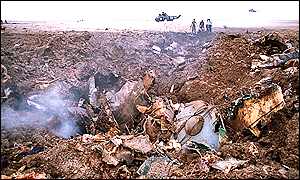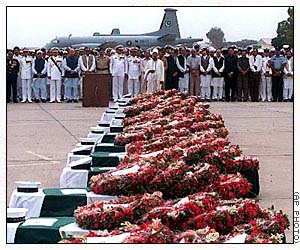
The Wreck
Home >> Other Ops & Incidents >> The Atlantique Kill >>
VayuSena
By Air Cmde Jasjit Singh (retd)
Institute for Defence Studies and Analysis, New Delhi
The Indian Air Force shot down a Pakistan’s Atlantique reconnaissance and strike aircraft which had unambiguously intruded well into Indian air space in a crucial sector. Lately there have been a number of such intrusions and it was inevitable that at some point there will be a sharp reaction by India. To the professionals, the purpose of intrusion is clear: that of probing the air defences and to identify gaps and weaknesses besides constructing an inventory of radar and communications inventories for future use and assessing readiness status.
The Atlantique is a maritime patrol and strike aircraft. The version that Pakistan has, carries a 3.5 tons of modern weapon load including bombs and air to surface missiles besides weapons specifically meant for anti-ship and anti-submarine role. The aircraft is capable of carrying air to air missiles of the Sidewinder type (a standard equipment with Pakistan). Sophisticated electronic systems are standard equipment. The pods on the wing tips are meant for electronic warfare in addition to the systems inside the fuselage. While the aircraft has a crew of 2-4 persons, it carries a compliment of 8 or more to manage the tactical systems including weapons and electronic intelligence warfare systems. A compliment of 16 as was the case would imply additional persons to monitor onboard radars and electronics intelligence systems. The mission of the Atlantique across the Indian border was obviously to probe Indian Air Force air defence "order of battle", radar and radio frequencies, reaction times etc. This was nothing but a plain and simple intelligence mission with known risks when violating airspace of another sovereign country with a combat aircraft.

The Wreck
The choice of the sector is also important. While there is little to reconnoiter over the Rann of Kutch. Indian air defence system in that area provides cover to vital assets like Koyali petrochemical complex, Gujrat –Suarasthtra industrial belt etc. Even of greater strategic significance is the hinterland of Trombay, Mumbai etc. It may be recalled that some years ago Pakistan Senior officers had talked about an earlier plan to strike at our nuclear installations in that area.
But Pakistan has been prompt in trying to obfuscate the issues. It is trying to create the impression that the aircraft was shot down in the vicinity of Sir Creek which is disputed by the two countries. But in reality all evidence points to the incident having taken place at the northern edge of Kori Creek which runs nearly 30 km parallel to the Sir Creek and well inside the Indian border even accordingly to Pakistani official atlas maps. Pakistan’s claim that this was a training mission is completely untenable for a number of reasons. Incidentally, the Information Minister Mushahid Hussein was initially cited by BBC as saying that the aircraft was on a "surveillance" mission. Firstly, all air force clearly demarcate flying training areas and these are located well away from international borders.
Secondly, the primary role of the Atlantique is operations over the seas and it would be strange to say the least for it to carry out training flight over land deep inside foreign territory.
Thirdly, beside the well-established international norms, there is a 1991 bilateral agreement between Pakistan and India based on Indian proposal on air violations. According to this treaty, "both sides will take adequate measures to ensure that the air violations of each others airspace do not take place " The agreement also specifies that "Combat aircraft (to include fighter, bomber, reconnaissance, jet military trainer and armed helicopter aircraft) will not fly within 10 Kms of each other’s airspace including ADIZ". The Atlantique clearly falls within this category of combat aircraft and should not have flown this mission. Even if we go by Pakistani official account, that aircraft was shot down 2 Km from the international border, the question must be asked how did the aircraft land up where it was found by the Indian Air Force and what was the aircraft doing violating the 1991 agreement.
Fourthly, Pakistani radars in that sector would have watched the progress of the aircraft’s flight (as much as the Indian Air Force radars did) and ought to have warned the crew if they had strayed from the flight plan. Pakistani foreign minister has publicly stated that Karachi radar had monitored the Atlantique shooting down. But he is quiet about the other radar stations watching the movement of the aircraft before it was shot down.
Fifthly, Pakistan Navy is now saying that the aircraft was on training mission while Nawaz Sharif’s close confident Information Minister Mushahid Hussein described the mission as that of surveillance.

There are rules and procedures to deal with air violations. The critical factor defining the rules of engagement by combat aircraft is the perceived actions of the intruder. These became clear as in this case when the flight is being monitored on radar for some time and the track behaviour is evaluated. This itself provides the first indication whether the flight is innocent or hostile. The issue here is not merely that the Pakistani aircraft was threatening the MiG fighters although since the aircraft is believed to be capable of carrying air-to-air missiles and is seen as turning towards you in a threatening way, no other conclusion can be reasonably drawn. But the issue really is that the Pakistani military reconnaissance/surveillance aircraft was engaged in a hostile act inside Indian territory in violation of all norms and agreements. Pakistan government is trying to project the impression that this was an unarmed aircraft. But the crucial point here is that it is capable of carrying a variety of modern sophisticated weapons besides cameras and other surveillance and reconnaissance equipment and is internationally acknowledged as a combat aircraft.
The reality is that Pakistan has again engaged in risky adventurism. The flight would have been approved at the highest levels of military leadership with full knowledge of the risks involved. The fact that Indian Air Force would be on high alert after three months of the war in Kargil itself may have provided the incentive to probe the capabilities and readiness of Indian air defence. This is not the first time that Pakistan has done this, though this may be the first time India has reacted firmly.
Pakistan military intrusion comes on the heels of massive aggression in the Kargil sector. Bilateral relations are bound to be further soured by the incident. But there is a need to deal with the issues with calm firmness. The Indian Air Force has again demonstrated that it is ready and competent to effectively defend the country. But our search for better relations with Pakistan must continue.
| Other Ops and Incidents | : | Official IAF Statement + Map |
| Other Ops and Incidents | : | Pictures of the Atlantique wreckage |
| Other Ops and Incidents | : | "Can't Stop the Madness" - TIME |

Comments or Questions? Contact Us
[Home] [The IAF Today] [Other Ops & Incidents] [Kargil 1999] [1980s] [1971] [1965] |
© VayuSena |
Top |